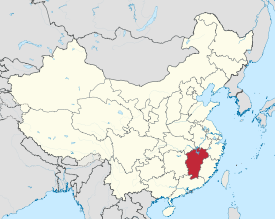
Back Jiangxi ACE Jiangxi Afrikaans جيانغشي Arabic Jiangxi AST Szyansi Azerbaijani Цзянси Bashkir Цзянсі Byelorussian Дзянси Bulgarian চিয়াংশি Bengali/Bangla ཅང་ཤིའི་ཞིང་ཆེན། Tibetan
Jiangxi
江西 | |
|---|---|
| Province of Jiangxi | |
| Name transcription(s) | |
| • Chinese | 江西省 (Jiāngxī Shěng) |
| • Abbreviation | JX / 赣 (pinyin: Gàn; Gan Chinese: Kōm) |
| • Gan | Kongsi |
| • Hakka Pinyim | Gong1 Si1 Sen3 |
 | |
 Map showing the location of Jiangxi Province | |
| Coordinates: 27°18′N 116°00′E / 27.3°N 116.0°E | |
| Country | China |
| Named for | Short for Jiangnanxi Circuit (江南西道) |
| Capital | Nanchang |
| Largest City | Ganzhou |
| Divisions | 11 prefectures, 99 counties, 1549 townships |
| Government | |
| • Type | Province |
| • Body | Jiangxi Provincial People's Congress |
| • CCP Secretary | Yin Hong |
| • Congress chairman | Yin Hong |
| • Governor | Ye Jianchun |
| • CPPCC chairman | Tang Yijun |
| Area | |
| • Total | 166,919 km2 (64,448 sq mi) |
| • Rank | 18th |
| Highest elevation | 2,158 m (7,080 ft) |
| Population (2020)[1] | |
| • Total | 45,188,635 |
| • Rank | 13th |
| • Density | 270/km2 (700/sq mi) |
| • Rank | 16th |
| Demographics | |
| • Ethnic composition | Han – 99.7% She – 0.2% |
| • Languages and dialects | Gan, Hakka, Huizhou, Wu, Jianghuai Mandarin |
| GDP[2] | |
| • Total | CN¥ 2.569 trillion US$ 372 billion |
| • Per capita | CN¥ 56,853 US$ 8,240 |
| ISO 3166 code | CN-JX |
| HDI (2019) | 0.741[3] (high) (19th) |
| Website | jiangxi.gov.cn |
| Jiangxi | |||||||||||||||||||||||||||||||||||
|---|---|---|---|---|---|---|---|---|---|---|---|---|---|---|---|---|---|---|---|---|---|---|---|---|---|---|---|---|---|---|---|---|---|---|---|
"Jiangxi" in Chinese characters | |||||||||||||||||||||||||||||||||||
| Chinese | 江西 | ||||||||||||||||||||||||||||||||||
| Gan | Kong si | ||||||||||||||||||||||||||||||||||
| Postal | Kiangsi | ||||||||||||||||||||||||||||||||||
| Literal meaning | "Western Jiang[nan]" | ||||||||||||||||||||||||||||||||||
| |||||||||||||||||||||||||||||||||||
Jiangxi[a] is an inland province in the east of the People's Republic of China. Its major cities include Nanchang and Jiujiang. Spanning from the banks of the Yangtze river in the north into hillier areas in the south and east, it shares a border with Anhui to the north, Zhejiang to the northeast, Fujian to the east, Guangdong to the south, Hunan to the west, and Hubei to the northwest.[6]
The name "Jiangxi" is derived from the circuit administrated under the Tang dynasty in 733, Jiangnanxidao.[b] The abbreviation for Jiangxi is "赣",[c] for the Gan River which runs across from the south to the north and flows into the Yangtze River. Jiangxi is also alternately called Ganpo Dadi[d] which literally means the "Great Land of Gan and Po".
After the fall of the Qing dynasty, Jiangxi became one of the earliest bases for the Communists and many peasants were recruited to join the growing people's revolution. The Nanchang Uprising took place in Jiangxi on August 1, 1927, during the Chinese Civil War. Later the Communist leadership hid in the mountains of southern and western Jiangxi, hiding from the Kuomintang's attempts to eradicate them. In 1931, the Chinese Soviet Republic's government was established in Ruijin, which is sometimes called the "Former Red Capital",[e] or just the "Red Capital". In 1935, after complete encirclement by the Nationalist forces, the Communists broke through and began the Long March to Yan'an.
The southern half of Jiangxi is hilly and mountainous, with ranges and valleys interspersed; notable mountains and mountain ranges include Mount Lu, the Jinggang Mountains and Mount Sanqing. The northern half is comparatively lower in altitude. The Gan River flows through the province.
Although the majority of Jiangxi's population is Han Chinese, Jiangxi is linguistically diverse. It is considered the center of Gan Chinese; Hakka Chinese, is also spoken to some degree. Jiangxi is rich in mineral resources, leading the provinces of China in deposits of copper, tungsten, gold, silver, uranium, thorium, tantalum, niobium and lithium.[8]
- ^ "Communiqué of the Seventh National Population Census (No. 3)". National Bureau of Statistics of China. 11 May 2021. Retrieved 11 May 2021.
- ^ GDP-2020 is a preliminary data "Home - Regional - Quarterly by Province" (Press release). China NBS. March 1, 2021. Retrieved March 23, 2021.
- ^ "Sub-national HDI - Subnational HDI - Global Data Lab". globaldatalab.org. Retrieved 2020-04-17.
- ^ "Jiangxi". Lexico UK English Dictionary. Oxford University Press. Archived from the original on May 19, 2021.
- ^ "Encyclopaedia Britannica". Retrieved 19 September 2017.
- ^ "www.ctoptravel.com". www.ctoptravel.com. Archived from the original on 2012-08-16. Retrieved 2012-12-24.
- ^ (in Chinese) Origin of the Names of China's Provinces Archived 2016-04-27 at the Wayback Machine, People's Daily Online.
- ^ "China's lithium mining likely to face more scrutiny". Reuters. 2023-03-01. Retrieved 2023-11-06.
Cite error: There are <ref group=lower-alpha> tags or {{efn}} templates on this page, but the references will not show without a {{reflist|group=lower-alpha}} template or {{notelist}} template (see the help page).
© MMXXIII Rich X Search. We shall prevail. All rights reserved. Rich X Search